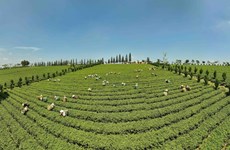Lao Cai tourism rises from promoting combined strengths
Enjoying natural preferences with abundant scenic spots, the northern
mountainous province of Lao Cai has reaped a number of successes in
tourism thanks to promoting its inner forces and making full use of
foreign cooperation.
Enjoying natural preferences with abundant scenic spots, the northern
mountainous province of Lao Cai has reaped a number of successes in
tourism thanks to promoting its inner forces and making full use of
foreign cooperation.
The province has welcomed nearly 700,000 visitors so far this year, including 300,000 foreigners. Earnings from the tourism sector hit 1.5 trillion VND (71.4 million USD).
The province expects to receive over 1 million arrivals this year, as its resort twon of celebrates its 110 th anniversary.
According to Tran Huu Son, Director of the provincial Culture, Sports and Tourism Department, China’s Yunnan province, the Aquitaine region of France and the Netherlands Development Organisation have been the three key partners of the province over the past years.
Sharing many similar natural and socio-economic conditions and cultural practices, Lao Cai and Yunnan have organised a number of talks and dialogues, through which they signed agreements to expand tours and diversify tourism products, attracting more investment.
The cooperation has yielded fruit as a number of tourist routes have been opened for Chinese tourists to Vietnam and those from Vietnam travelling to China. Inter-regional tour routes and community tours have been exploited for years.
Particularly, Lao Cai shares close tourism ties with Yunnan’s Hekou district.
Meanwhile, cooperation between the province and the Aquitaine region of France has helped Lao Cai make full use of its advantages though urban planning and the expansion of Sa Pa, a key tourist destination in the province.
The French locality has assisted Lao Cai in developing its ecotourism and preserving biodiversity in Hoang Lien mountain region and Sa Pa in particular.
At the same time, the province has boosted community tourism in some communes such as Ban Ho, Ta Phin and Ta Van, with the support of the Netherlands Development Organisation.
Since 2007, Lao Cai’s tourism sector has taken giant steps in regional and international integration. Through many cultural and tourism events, conferences, promotions and international fairs such as the Vietnam-China Trade Fair, the 7 th International Tourism Fair in Ho Chi Minh City in 2011, the Vietnam International Tourism Fair in Hanoi and the Kunming International Fair earlier this year, the image of Lao Cai has become closer to visitors in and outside the country.
Located about 300 kilometres from the capital city, Lao Cai is home to about 27 ethnic minority groups.
Lao Cai is a treasure chest of biodiversity, with many special cultural and historical sites.
Visitors to Sa Pa in summer can feel the four seasons in one day, discovering interesting places including Ham Rong Mountain, Silver Waterfall, Rattan Bridge, Bamboo forest, Ta Phin Cave and Sa Pa’s ancient rock field. Taking place every Saturday night, Sa Pa Market is an attractive place for visitors who are keen on exploring traditional cultures.
In addition, Bac Ha Market hosts the biggest fair near the mountainous highlands, with a fascinating annual horse race. In Cat Cat Village many H'Mong residents are good at manipulating gold and silver jewellery.
Australia’s travel magazine Lonely Planet has listed Sa Pa as one of the 10 best walking sites in the world for tourists, while Sri Lanka’s Serendib has described Bac Ha minority cultural market as one of the 10 most attractive markets in Southeast Asia.
US-based Travel and Leisure Magazine has named Sa Pa’s terraced rice fields as one of the seven most magnificent examples in the world.-VNA
The province has welcomed nearly 700,000 visitors so far this year, including 300,000 foreigners. Earnings from the tourism sector hit 1.5 trillion VND (71.4 million USD).
The province expects to receive over 1 million arrivals this year, as its resort twon of celebrates its 110 th anniversary.
According to Tran Huu Son, Director of the provincial Culture, Sports and Tourism Department, China’s Yunnan province, the Aquitaine region of France and the Netherlands Development Organisation have been the three key partners of the province over the past years.
Sharing many similar natural and socio-economic conditions and cultural practices, Lao Cai and Yunnan have organised a number of talks and dialogues, through which they signed agreements to expand tours and diversify tourism products, attracting more investment.
The cooperation has yielded fruit as a number of tourist routes have been opened for Chinese tourists to Vietnam and those from Vietnam travelling to China. Inter-regional tour routes and community tours have been exploited for years.
Particularly, Lao Cai shares close tourism ties with Yunnan’s Hekou district.
Meanwhile, cooperation between the province and the Aquitaine region of France has helped Lao Cai make full use of its advantages though urban planning and the expansion of Sa Pa, a key tourist destination in the province.
The French locality has assisted Lao Cai in developing its ecotourism and preserving biodiversity in Hoang Lien mountain region and Sa Pa in particular.
At the same time, the province has boosted community tourism in some communes such as Ban Ho, Ta Phin and Ta Van, with the support of the Netherlands Development Organisation.
Since 2007, Lao Cai’s tourism sector has taken giant steps in regional and international integration. Through many cultural and tourism events, conferences, promotions and international fairs such as the Vietnam-China Trade Fair, the 7 th International Tourism Fair in Ho Chi Minh City in 2011, the Vietnam International Tourism Fair in Hanoi and the Kunming International Fair earlier this year, the image of Lao Cai has become closer to visitors in and outside the country.
Located about 300 kilometres from the capital city, Lao Cai is home to about 27 ethnic minority groups.
Lao Cai is a treasure chest of biodiversity, with many special cultural and historical sites.
Visitors to Sa Pa in summer can feel the four seasons in one day, discovering interesting places including Ham Rong Mountain, Silver Waterfall, Rattan Bridge, Bamboo forest, Ta Phin Cave and Sa Pa’s ancient rock field. Taking place every Saturday night, Sa Pa Market is an attractive place for visitors who are keen on exploring traditional cultures.
In addition, Bac Ha Market hosts the biggest fair near the mountainous highlands, with a fascinating annual horse race. In Cat Cat Village many H'Mong residents are good at manipulating gold and silver jewellery.
Australia’s travel magazine Lonely Planet has listed Sa Pa as one of the 10 best walking sites in the world for tourists, while Sri Lanka’s Serendib has described Bac Ha minority cultural market as one of the 10 most attractive markets in Southeast Asia.
US-based Travel and Leisure Magazine has named Sa Pa’s terraced rice fields as one of the seven most magnificent examples in the world.-VNA












